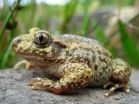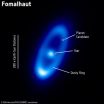(Press-News.org) The roads are the main cause of fragmenting the habitats of many species, especially amphibians, as they cause them to be run over and a loss of genetic diversity. Furthermore, traffic harms two abundant species that represent the amphibious Asturian fauna and have been declared vulnerable in Spain: the midwife toad (Alytes obstetricans) and the palmate newt (Lissotriton helveticus).
"But midwife toad and palmate newt populations have very different sensitivities to the effects of roads" Claudia García-González, researcher at the University of Oviedo, told SINC. "These amphibians have very different dispersal capabilities".
From various DNA tests, Eva García Vazquez's team have analysed the correlation between the number of roads that the amphibians have to cross to travel from one colony to another and the intensity of the genetic barriers between them. This way she has determined how the traffic affected them.
The results, published in Landscape and Urban Planning, show that in the Trubia valley (Oviedo) midwife toad populations are most affected by motor traffic and are much more broken up and isolated than the newts.
In the last decade amphibians have experienced a decline all over the planet, which is why "they are currently highly vulnerable species and many of them are subject to special protection," García-González explains.
Plant corridors to protect the toads
Amongst measures for reducing the impact of roads on animals, traffic alleviation is highlighted. The researcher points out that "decongestion measures in rural areas efficiently minimise the impact on newts, but not on midwife toads".
According to the study, even small roads with little traffic act as barriers for midwife toads, and therefore this measure is not enough to protect this species.
"A reduction in the number and speed of vehicles should be added to other actions, such as building plant corridors or passages to help connect humid areas with water habitats" García-González suggests.
In order to minimise the effect of roads on biodiversity "it does not seem appropriate to only consider one strategy to protect amphibians. We must consider the individual needs of each species and take into account that there are many factors that impact on them" the biologist warns.
Furthermore, "many animals, apart from amphibians, could benefit from building paths on existing bridges or new pathways for crossing rivers" the expert concludes.
INFORMATION:
Referencia bibliográfica:
Garcia-Gonzalez C.; Campo D.; Pola I.G.; Garcia-Vazquez E. "Rural road networks as barriers to gene flow for amphibians: Species-dependent mitigation by traffic calming" Landscape and urban planning 104 [2]: 171-180, febrero 2012.
DOI: 10.1016/j.landurbplan.2011.10.012
Traffic harms Asturian amphibians
2012-04-13
ELSE PRESS RELEASES FROM THIS DATE:
Nutrient and toxin all at once: How plants absorb the perfect quantity of minerals
2012-04-13
In order to survive, plants should take up neither too many nor too few minerals from the soil. New insights into how they operate this critical balance have now been published by biologists at the Ruhr-Universität in a series of three papers in the journal The Plant Cell. The researchers discovered novel functions of the metal-binding molecule nicotianamine. "The results are important for sustainable agriculture and also for people – to prevent health problems caused by deficiencies of vital nutrients in our diet" says Prof. Dr. Ute Krämer of the RUB Department of Plant ...
Herschel sees dusty disc of crushed comets
2012-04-13
Astronomers using ESA's Herschel Space Observatory have studied a ring of dust around the nearby star Fomalhaut and have deduced that it is created by the collision of thousands of comets every day.
Fomalhaut, a star twice as massive as our Sun and around 25 light years away, has been of keen interest to astronomers for many years. With an age of only a few hundred million years it is a fairly young star, and in the 1980s was shown to be surrounded by relatively large amounts of dust by the IRAS infrared satellite. Now Herschel, with its unprecedented resolution, has ...
Study resolves debate on human cell shut-down process
2012-04-13
Researchers at the University of Liverpool have resolved the debate over the mechanisms involved in the shut-down process during cell division in the body.
Research findings, published in the journal PNAS, may contribute to future studies on how scientists could manipulate this shut-down process to ensure that viruses and other pathogens do not enter the cells of the body and cause harm.
Previous research has shown that when cells divide, they cannot perform any other task apart from this one. They cannot, for example, take in food and fluids at the same time as ...
Multitasking – not so bad for you after all?
2012-04-13
Our obsession with multiple forms of media is not necessarily all bad news, according to a new study by Kelvin Lui and Alan Wong from The Chinese University of Hong Kong. Their work shows that those who frequently use different types of media at the same time appear to be better at integrating information from multiple senses - vision and hearing in this instance - when asked to perform a specific task. This may be due to their experience of spreading their attention to different sources of information while media multitasking. Their study is published online in Springer's ...
New advances in the understanding of cancer progression
2012-04-13
Researchers at the Hospital de Mar Research Institute (IMIM) have discovered that the protein LOXL2 has a function within the cell nucleus thus far unknown. They have also described a new chemical reaction of this protein on histone H3 that would be involved in gene silencing, one of which would be involved in the progression of breast, larynx, lung and skin tumours.
Led by Dr Sandra Peiró and published in Molecular Cell journal, the study is a significant advance in describing the evolution of tumours and opens the door to researching new treatments that block their ...
Genetic adaptation of fat metabolism key to development of human brain
2012-04-13
About 300 000 years ago humans adapted genetically to be able to produce larger amounts of Omega-3 and Omega-6 fatty acids. This adaptation may have been crucial to the development of the unique brain capacity in modern humans. In today's life situation, this genetic adaptation contributes instead to a higher risk of developing disorders like cardiovascular disease.
The human nervous system and brain contain large amounts of polyunsaturated fatty acids, and these are essential for the development and function of the brain. These Omega-3 and Omega-6 fatty acids occur ...
Stem cells 'by default'
2012-04-13
Casanova's notion is that stem cells emerge not because of the presence of factors that confer capacity to the stem cell but because of factors that repress the cellular signals for differentiation and specialization. Casanova believes that somehow all non-differentiated cells intrinsically carry the qualities of the stem cell by default and that there are factors at work that remove these capacities. Said another way: a stem cell is a stem cell because it has evaded differentiation. According to Casanova, if the idea of "a stem cell by default" is considered, research ...
Gulf Coast residents say BP Oil Spill changed their environmental views, UNH research finds
2012-04-13
DURHAM, N.H. -- University of New Hampshire researchers have found that residents of Louisiana and Florida most acutely and directly affected by the BP Deepwater Horizon disaster -- the largest marine oil spill in U.S. history -- said they have changed their views on other environmental issues as a result of the spill.
"If disasters teach any lessons, then experience with the Gulf oil spill might be expected to alter opinions about the need for environmental protection. About one-fourth of our respondents said that as a result of the spill, their views on other environmental ...
Biomarker family found for chemo resistant breast cancers
2012-04-13
Biomarkers which could help to predict resistance to chemotherapy in breast cancer patients have been identified by researchers from the University of Hull, UK.
The researchers found a family of proteins to be twice as prevalent in clinical samples obtained from breast cancer patients who were resistant to chemotherapy than those who were successfully treated.
Chemotherapy resistance is a major problem for some types of breast cancer and many patients undergo treatment that does not work, delaying other more suitable treatments and subjecting the patient to adverse ...
ALMA reveals workings of nearby planetary system
2012-04-13
The discovery was made possible by exceptionally sharp ALMA images of a disc, or ring, of dust orbiting Fomalhaut, which lies about 25 light-years from Earth. It helps resolve a controversy among earlier observers of the system. The ALMA images show that both the inner and outer edges of the thin, dusty disc have very sharp edges. That fact, combined with computer simulations, led the scientists to conclude that the dust particles in the disc are kept within the disc by the gravitational effect of two planets — one closer to the star than the disc and one more distant [1].
Their ...



